- Home
- Carl Sagan
The Cosmic Connection
The Cosmic Connection Read online
CARL SAGAN
The Cosmic Connection
An Extraterrestrial Perspective
Published by
DELL PUBLISHING CO., INC.
1 Dag Hammarskjold Plaza
New York, New York 10017
Copyright © 1973 by Carl Sagan and Jerome Agel
All rights reserved. For information contact
Doubleday & Company, Inc., New York, New York
Dell ® TM 681510, Dell Publishing Co., Inc.
Reprinted by arrangement with Doubleday & Company, Inc.
Printed in the United States of America
First Dell printing-March 1975
Dr. Carl Sagan, the author of The Cosmic Connection, is Professor of Astronomy and Space Sciences and Director of the Laboratory for Planetary Studies at Cornell University. He received NASA's Medal for Exceptional Scientific Achievement for his studies of Mars with Mariner 9; he was responsible for placing the message from Earth aboard the interstellar spacecraft Pioneer 10; and he chaired the U.S. delegation to the U.S./U.S.S.R. Conference on Communication with Extraterrestrial Intelligence. Dr. Sagan was awarded in 1973 the Prix Galabert – the international astronautics prize. He is editor of the planetary science journal Icarus and is widely known for his studies of the planets, the origin of life, and the prospects for life beyond the Earth. He is formerly of the Harvard, Caltech and Stanford Medical School faculties.
Jerome Agel is the producer of The Cosmic Connection. His fourteen book productions include: Herman Kahnsciousness, Understanding Understanding (with Humphrey Osmond), The Medium Is the Massage (with Marshall McLuhan), The Making of Kubrick's "2001," Is Today Tomorrow? (a synergistic collage of alternative futures), I Seem to Be a Verb (with Buckminster Fuller), A World Without – What Our Presidents Didn't Know, Surprising Facts About U.S. History, Right on Time (with Alan Lakein), The Fasting Diet: How to Lose Weight Without Eating (with Allan Cott), and Rough Times.
For Dorion, Jeremy, and Nicholas, my sons. May their future – and the future of all human and other beings – be bright with promise.
Contents
Preface
Part One: COSMIC PERSPECTIVES
1. A Transitional Animal
2. The Unicorn of Cetus
3. A Message from Earth
4. A Message to Earth
5. Experiments in Utopias
6. Chauvinism
7. Space Exploration as a Human Enterprise
I. The Scientific Interest
8. Space Exploration as a Human Enterprise
II. The Public Interest
9. Space Exploration as a Human Enterprise
III. The Historical Interest
Part Two: THE SOLAR SYSTEM
10. On Teaching the First Grade
11. "The Ancient and Legendary Gods of Old"
12. The Venus Detective Story
13. Venus Is Hell
14. Science and "Intelligence"
15. The Moons of Barsoom
16. The Mountains of Mars
I. Observations From Earth
17. The Mountains of Mars
II. Observations From Space
18. The Canals of Mars
19. The Lost Pictures of Mars
20. The Ice Age and the Cauldron
21. Beginnings and Ends of the Earth
22. Terraforming the Planets
23. The Exploration and Utilization of the Solar System
Part Three: BEYOND THE SOLAR SYSTEM
24. Some of My Best Friends Are Dolphins
25. "Hello, Central Casting? Send Me Twenty Extraterrestrials"
26. The Cosmic Connection
27. Extraterrestrial Life: An Idea Whose Time Has Come
28. Has the Earth Been Visited?
29. A Search Strategy for Detecting Extraterrestrial Intelligence
30. If We Succeed
31. Cables, Drums, and Seashells
32. The Night Freight to the Stars
33. Astroengineering
34. Twenty Questions: A Classification of Cosmic Civilizations
35. Galactic Cultural Exchanges
36. A Passage to Elsewhen
37. Starfolk
I. A Fable
38. Starfolk
II. A Future
39. Starfolk
III. The Cosmic Cheshire Cats
Preface
When I was twelve, my grandfather asked me – through a translator (he had never learned much English) – what I wanted to be when I grew up. I answered, "An astronomer," which, after a while, was also translated. "Yes," he replied, "but how will you make a living?"
I had supposed that, like all the adult men I knew, I would be consigned to a dull, repetitive, and uncreative job, astronomy would be done on weekends. It was not until my second year in high school that I discovered that some astronomers were paid to pursue their passion. I was overwhelmed with joy; I could pursue my interest full-time.
Even today, there are moments when what I do seems to me like an improbable, if unusually pleasant, dream: To be involved in the exploration of Venus, Mars, Jupiter, and Saturn; to try to duplicate the steps that led to the origin of life four billion years ago on an Earth very different from the one we know; to land instruments on Mars to search there for life; and perhaps to be engaged in a serious effort to communicate with other intelligent beings, if such there be, out there in the dark of the night sky.
Had I been born fifty years earlier, I could have pursued none of these activities. They were then all figments of the speculative imagination. Had I been born fifty years later, I also could not have been involved in these efforts, except possibly the last, because fifty years from now the preliminary reconnaissance of the Solar System, the search for life on Mars, and the study of the origin of life will have been completed. I think myself extraordinarily fortunate to be alive at the one moment in the history of mankind when such ventures are being undertaken.
So when Jerome Agel approached me about doing a popular book to try to communicate my sense of the excitement and importance of these adventures, I was amenable – even though his suggestion came just before the Mariner 9 mission to Mars, which I knew would occupy most of my waking hours for many months. At a later time, after discussing communication with extraterrestrial intelligence, Agel and I had dinner in a Polynesian restaurant in Boston. My fortune cookie announced, "You will shortly be called upon to decipher an important message." This seemed a good omen.
After centuries of muddy surmise, unfettered speculation, stodgy conservatism, and unimaginative disinterest, the subject of extraterrestrial life has finally come of age. It has now reached a practical stage where it can be pursued by rigorous scientific techniques, where it has achieved scientific respectability and where its significance is widely understood. Extraterrestrial life is an idea whose time has come.
This book is divided into three major sections. In the first part I try in several ways to convey a sense of cosmic perspective – living out our lives on a tiny hunk of rock and metal circling one of 250 billion stars that make up our galaxy in a universe of billions of galaxies. The deflation of some of our more common conceits is one of the practical applications of astronomy. The second part of the book is concerned with various aspects of our Solar System – mostly with Earth, Mars, and Venus. Some of the results and implications of Mariner 9 can be found here. Part Three is devoted to the possibility of communicating with extraterrestrial intelligence on planets of other stars. Since no such contact has yet been made – our efforts to date have been feeble – this section is necessarily speculative. I have not hesitated to speculate within what I perceive to be the bounds of scientific plausibility. And, although I am not by training a philosopher or sociologist or h
istorian, I have not hesitated to draw philosophical or social or historical implications of astronomy and space exploration.
The astronomical discoveries we are in the midst of making are of the broadest human significance. If this book plays a small role in broadening public consideration of these exploratory ventures, it will have served its purpose.
As with all ongoing work and especially all speculative subjects, some of the statements in these pages will elicit vigorous demurrers. There are other books with other opinions. Reasoned disputation is the lifeblood of science – as is, sadly, infrequently the case in the intellectually more anemic arena of politics. But I believe that the more controversial opinions expressed here have, nevertheless, a significant scientific constituency. I have purposely introduced the same concept in slightly different contexts in a few places where I felt the discussion required it. The book is carefully structured, but, for the reader who wishes to browse ahead, most chapters are self-contained.
There are far too many who helped shape my opinions on these subjects for me to thank them all here. But in rereading these chapters, I find I owe a special debt to Joseph Veverka and Frank Drake, both of Cornell University, with whom over the past few years I have discussed so many aspects of this volume. The book was composed partly during a very long transcontinental trip in a very short automobile. I thank Linda and Nicholas for their encouragement and patience. I am also grateful to Linda for drawing two handsome humans and one elegant unicorn. And I am grateful to the late Mauritz Escher for permission to reproduce his "Another World" and to Robert Macintyre for the human figure and star field in Part Three. Jon Lomberg's paintings and drawings have been a source of intellectual and aesthetic excitement for me, and I am grateful to him for producing many of them especially for this book. Hermann Eckleman's careful photographic reproductions of Lomberg's work have facilitated their appearance in this book. And I thank Jerome Agel, without whose time and persistence this book would never have been written.
I am indebted to John Naugle of NASA for showing me his file on public response to the Pioneer 10 plaque; the Oregon System of Higher Education for permission to reproduce some ideas from my book Planetary Exploration; the Forum for Contemporary History, in Santa Barbara, for permission to reproduce a portion of my letter distributed by the Forum in January 1973; and Cornell University Press for permission to reprint a fraction of my chapter "The Extraterrestrial and Other Hypotheses" from UFO's: A Scientific Debate, edited by Carl Sagan and Thornton Page, Cornell University Press, 1972. I am also grateful to those who have granted me permission to reproduce in Chapter 4 their remarks on the Pioneer 10 plaque. The evolution of this book through many drafts owes much to the technical skills of Jo Ann Cowan, and, especially, Mary Szymanski.
– Carl Sagan
Part One:
COSMIC PERSPECTIVES
We shall not cease from exploration
And the end of all our exploring
Will be to arrive where we started
And know the place for the first time…
When the tongues of flame are in-folded
Into the crowned knot of fire
And the fire and the rose are one.
– T. S. Eliot, Four Quartets
1. A Transitional Animal
Five billion years ago, when the Sun turned on, the Solar System was transformed from inky blackness to a flood of light. In the inner parts of the Solar System, the early planets were irregular collections of rock and metal – the debris, the minor constituents of the initial cloud, the material that had not been blown away after the Sun ignited.
These planets heated as they formed. Gases trapped in their interiors were exuded to form atmospheres. Their surfaces melted. Volcanoes were common.
The early atmospheres were composed of the most abundant atoms and were rich in hydrogen. Sunlight, falling on the molecules of the early atmosphere, excited them, induced molecular collisions, and produced larger molecules. Under the inexorable laws of chemistry and physics these molecules interacted, fell into the oceans, and further developed to produce larger molecules – molecules much more complex than the initial atoms of which they had formed, but still microscopic by any human standard.
These molecules, remarkably enough, are the ones of which we are made: The building blocks of the nucleic acids, which are our hereditary material, and the building blocks of the proteins, the molecular journeymen that perform the work of the cell, were produced from the atmosphere and oceans of the early Earth. We know this because we can make these molecules today by duplicating the primitive conditions.
Eventually, many billions of years ago, a molecule was formed that had a remarkable capability. It was able to produce, out of the molecular building blocks of the surrounding waters, a fairly accurate copy of itself. In such a molecular system there is a set of instructions, a molecular code, containing the sequence of building blocks from which the larger molecule is constructed. When, by accident, there is a change in the sequence, the copy is likewise changed. Such a molecular system – capable of replication, mutation, and replication of its mutations – can be called "alive." It is a collection of molecules that can evolve by natural selection. Those molecules able to replicate faster, or to reprocess building blocks from their surroundings into a more useful variety, reproduced more efficiently than their competitors – and eventually dominated.
But conditions gradually changed. Hydrogen escaped to space. Production of the molecular building blocks declined. The foodstuffs formerly available in great abundance dwindled. Life was expelled from the molecular Garden of Eden. Only those simple collections of molecules able to transform their surroundings, able to produce efficient molecular machines for the conversion of simple into complex molecules, were able to survive. By isolating themselves from their surroundings, by maintaining the earlier idyllic conditions, those molecules that surrounded themselves by membranes had an advantage. The first cells arose.
With molecular building blocks no longer available for free, organisms had to work hard to make such building blocks. Plants are the result. Plants start with air and water, minerals and sunlight, and produce molecular building blocks of high complexity. Animals, such as human beings, are parasites on the plants.
Changing climate and competition among what was now a wide diversity of organisms produced greater and greater specialization, a sophistication of function, and an elaboration of form. A rich array of plants and animals began to cover the Earth. Out of the initial oceans in which life arose, new environments, such as the land and the air, were colonized. Organisms now live from the top of Mount Everest to the deepest portions of the abyssal depths. Organisms live in hot, concentrated solutions of sulfuric acid and in dry Antarctic valleys. Organisms live on the water adsorbed on a single crystal of salt.
Life forms developed that were finely attuned to their specific environments, exquisitely adapted to the conditions. But the conditions changed. The organisms were too specialized. They died. Other organisms were less well adapted, but they were more generalized. The conditions changed, the climate varied, but the organisms were able to continue. Many more species of organisms have died during the history of the Earth than are alive today. The secret of evolution is time and death.
Among the adaptations that seem to be useful is one that we call intelligence. Intelligence is an extension of an evolutionary tendency apparent in the simplest organisms – the tendency toward control of the environment. The standby biological method of control has been the hereditary material: Information passed on by nucleic acids from generation to generation – information on how to build a nest; information on the fear of falling, or of snakes, or of the dark; information on how to fly south for the winter. But intelligence requires information of an adaptive quality developed during the lifetime of a single individual. A variety of organisms on the Earth today have this quality we call intelligence: The dolphins have it, and so do the great apes. But it is most evident in the organism c
alled Man.
In Man, not only is adaptive information acquired in the lifetime of a single individual, but it is passed on extra-genetically through learning, through books, through education. It is this, more than anything else, that has raised Man to his present pre-eminent status on the planet Earth.
We are the product of 4.5 billion years of fortuitous, slow, biological evolution. There is no reason to think that the evolutionary process has stopped. Man is a transitional animal. He is not the climax of creation.
The Earth and the Sun have life expectancies of many more billions of years. The future development of man will likely be a cooperative arrangement among controlled biological evolution, genetic engineering, and an intimate partnership between organisms and intelligent machines. But no one is in a position to make accurate predictions of this future evolution. All that is clear is that we cannot remain static.
In our earliest history, so far as we can tell, individuals held an allegiance toward their immediate tribal group, which may have numbered no more than ten or twenty individuals, all of whom were related by consanguinity. As time went on, the need for cooperative behavior – in the hunting of large animals or large herds, in agriculture, and in the development of cities – forced human beings into larger and larger groups. The group that was identified with, the tribal unit, enlarged at each stage of this evolution. Today, a particular instant in the 4.5-billion-year history of Earth and in the several-million-year history of mankind, most human beings owe their primary allegiance to the nation-state (although some of the most dangerous political problems still arise from tribal conflicts involving smaller population units).
Many visionary leaders have imagined a time when the allegiance of an individual human being is not to his particular nation-state, religion, race, or economic group, but to mankind as a whole; when the benefit to a human being of another sex, race, religion, or political persuasion ten thousand miles away is as precious to us as to our neighbor or our brother. The trend is in this direction, but it is agonizingly slow. There is a serious question whether such a global self-identification of mankind can be achieved before we destroy ourselves with the technological forces our intelligence has unleashed.

 Cosmos
Cosmos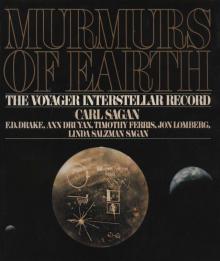 Murmurs of Earth
Murmurs of Earth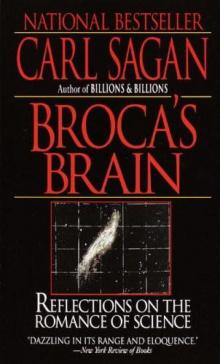 Broca's Brain
Broca's Brain Comet
Comet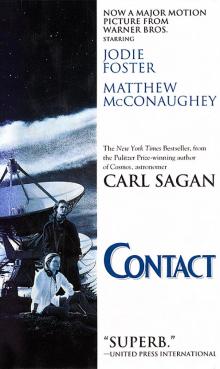 Contact
Contact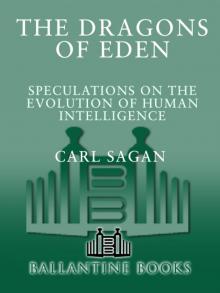 Dragons of Eden
Dragons of Eden Cosmic Connection
Cosmic Connection Shadows of Forgotten Ancestors
Shadows of Forgotten Ancestors Billions & Billions
Billions & Billions Comet, Revised
Comet, Revised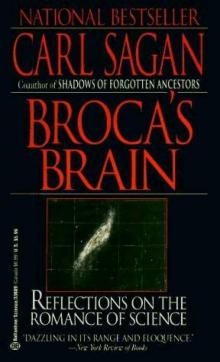 Broca's Brain: The Romance of Science
Broca's Brain: The Romance of Science The Varieties of Scientific Experience: A Personal View of the Search for God
The Varieties of Scientific Experience: A Personal View of the Search for God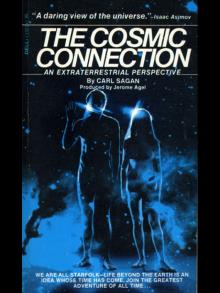 The Cosmic Connection
The Cosmic Connection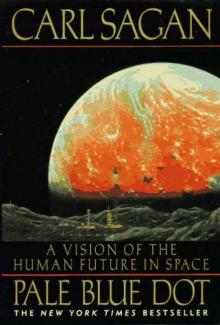 Pale Blue Dot: A Vision of the Human Future in Space
Pale Blue Dot: A Vision of the Human Future in Space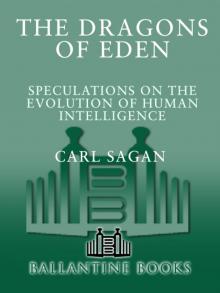 The Dragons of Eden
The Dragons of Eden